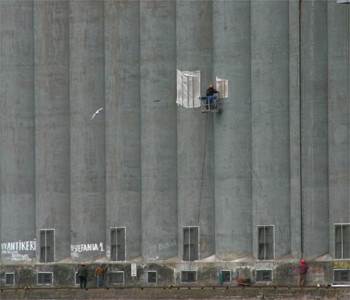The first saltie of the season didn’t quite sail smoothly into the Thunder Bay harbour Thursday morning.
As the Federal Saguenay prepared to dock at the Viterra C elevator at about 9:30 a.m. yesterday, the ship made contact with one of the grain bins.
Thunder Bay Port Authority CEO Tim Heney said it’s a highly unusual occurrence and he’s not sure what the cause of the incident was.
“It was very foggy,” he said. “It’s nothing major; nobody was hurt. It’s going to be corrected by the end of next week.”
No major repairs are required for the ship and just a bit of concrete work is needed to patch the hole in the grain elevator; Heney said they lost a minimal amount of grain.
Captained by Sandeep Gawde, the Saguenay is not new to the city; it’s a common visitor and is here to pick up 15,724 tonnes of flax and 5,453 tonnes of canary seed. The saltie is bound for Ghent, Belgium.
While the port authority celebrates the first laker and first saltie of the season, Heney said the arrival of the season’s first ocean vessel is a bit magical.
“To be able to bring an ocean vessel 2,300 miles inland to Thunder Bay is really one of the wonders of the world and it’s always the sign of spring for us,” he said. “The fact you can bring a ship from anywhere in the world to Thunder Bay is something that’s always amazing to us and seeing the first one is always an exciting time.”
The Saguenay travels to Europe, North Africa and central South America and Heney said it will spend the summer months coming back and forth up the seaway to Thunder Bay.
Thunder Bay usually sees about 400 ships a year. Last year 65 were salties. Heney said the city is mainly an export port but the port authority is trying to attract more inbound cargo.
“About 90 per cent of our cargo is export, usually bulk commodities like grain and potash, but we’re trying to encourage more inbound general cargo for the west,” he said. “It’s one of the original design purposes of the seaway and we’re trying to diversify cargo inbound to Thunder Bay for furtherance to Alberta, Manitoba and Saskatchewan.”
He added this year the port has wind turbines for the west coming through and they’ve also had success with oil sands project cargo.“We’re trying to get that as more regular service to Thunder Bay,” he said.
